Results 1 to 10 of 596
Thread: Thú
Hybrid View
-
01-07-2021, 07:59 PM #1
Thú
Độc hơn thịt vịt:
Calls for mass duck cull in France as bird flu hits foie gras industry
https://www.theguardian.com/world/20...-gras-industry
Don't eat duck, then.The highly pathogenic H5N8 virus was first detected in a bird in a pet shop on the Mediterranean island of Corsica in November before spreading to duck farms on the mainland in December.Several European countries have reported cases of infection, five years after a major outbreak prompted the slaughter of millions of ducks in France.
The number of outbreaks in France had now risen to 124, the ministry of agriculture said on Thursday, adding that about 350,000 ducks had been slaughtered since 24 December.
Earlier this week the government’s chief veterinary officer, Loic Evain, said more than 200,000 ducks had already been slaughtered and that a further 400,000 birds were set to be culled, out of about 35 million reared each year.
He described the virus, which is not harmful to humans, as “very, very contagious”.
Officials in Belgium said on Thursday they had culled three contaminated poultry flocks – one in Menin, in the west of the country, another in Dinant in the south and a third in Dixmude in western Flanders.
Belgium’s federal food safety agency AFSCA, which has ordered poultry owners to lock up their animals to avoid contamination, said that 20 cases of the virus had been found in wild birds.
Herve Dupouy, a French producer who heads the local poultry section of the FNSEA farmers federation in the Landes department, a bastion of the foie gras industry, said “the situation is out of control.”
He called on the state to cull all poultry flocks in the area and impose a two-month production freeze. “There’s no other solution,” he said.
So far the authorities have been culling all ducks and geese within a three-kilometre radius of an infected flock. Free-range chickens and turkeys within that range have also been slaughtered.
Producers of foie gras, a pate made from the livers of force-fed ducks or geese, fear a repeat of the devastation wrought by two previous waves of bird flu in the winters of 2015/2016 and 2016/2017.
More than 25m ducks were culled in the first outbreak, followed by 4.5m the following year, causing a steep decline in foie gras production.
Besides France and Belgium, the Netherlands, Sweden, Britain and Ireland have also reported bird flu outbreaks since the winter began.
Dutch authorities culled 190,000 chickens in November after the discovery of the virus at two farms.
Outbreaks have also been reported in India and South Korea. In India, tens of thousands of poultry will be slaughtered after an outbreak of deadly avian influenza was found to have killed scores of birds across the country.
At least six Indian states have stepped up efforts this week to contain two strains of bird flu – H5N1 and H5N8 – after the deaths of thousands of migratory birds, ducks, crows and chickens.
South Korea’s agriculture ministry said on Thursday that it had so far culled 14.9m poultry since identifying its first farm-linked, highly pathogenic bird flu case in late November.
-
01-07-2021, 08:07 PM #2
Trăm cá voi không được một bát nước sáo:
Minke whale trapped in nets in Japan for two weeks
https://www.theguardian.com/world/20...-for-two-weeks
Don't eat whale.Japanese media reported that attempts were being made to free the four or five metre long whale but fishermen claimed its size and strong tidal currents were making it difficult to guide it into open water.Ren Yabuki – an animal rights activist who has been filming the whale with a drone every day since it became trapped on Christmas Eve – said fishermen had made only one brief attempt to release the animal, adding that its fate appeared to have been decided.
If they slaughter the whale, fishermen would be able to sell its meat after taking a DNA sample, Yabuki added. “Allowing the whale to starve to death would be the worst possible end to this, so the only other option would be to draw in the net and send divers into the sea to kill it with spears.”
Georgie Dolphin, animal welfare programme manager at Humane Society International [HSI] in Australia, said the whale had become “increasingly distressed and agitated, ramming the nets and deep diving in an effort to escape”.
In a rare interview, fishermen told the Guardian that the hunts were legal under Japanese law and provided a vital source of income for the town, located on a remote part of the Pacific coastline.
-
01-08-2021, 06:58 AM #3
Sốc vì sóc:
‘It was angry, vicious’: spate of squirrel attacks leave NYC neighborhood in fear
https://www.theguardian.com/world/2021/jan/08/squirrel-attacks-nyc-neighborhood-fear
Don't eat people.At least three people in Rego Park, in the borough of Queens, have been jumped upon and bitten by the possibly deranged squirrel in recent weeks. The tree-based rodent’s reign of terror has made some people in the area afraid to go outside without being armed with pepper spray or other anti-squirrel weaponry.
“A few people are quite scared,” Micheline Frederick, a local resident, told Guardian US. Frederick was herself targeted by the squirrel in a bloody attack on 21 December, when she was holding her front door open for furniture movers.
“Suddenly the squirrel ran up my leg and I thought ‘it’s a small rodent, how bad could this be’, so I stood completely still and they next thing I knew the blood started to fly. It was a wrestling match that got very bloody very quickly,” Frederick said.
It’s unclear what has prompted the highly unusual behavior from the squirrel, although the animals can act atypically if suffering from disease or overly used to being fed by people.
-
01-08-2021, 10:34 PM #4
Các biên phúc công tử giá lâm....
Flying foxes: Australia's love-hate relationship with fruit bats
Australian towns have made headlines complaining of "bat tornadoes." But ecologists say flying foxes are vital to preserving forest and need protection from climate change and habitat loss.
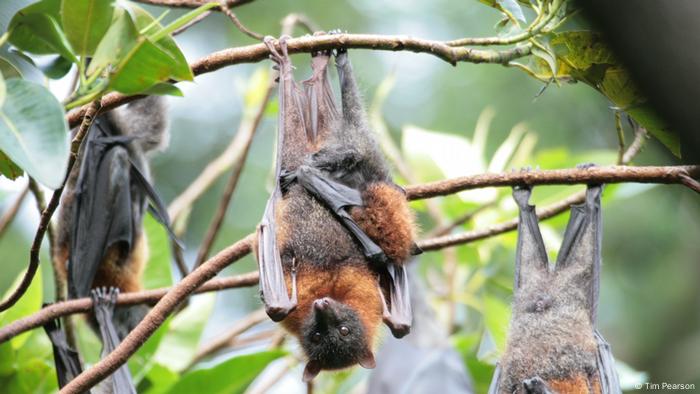
The Australian grey-headed flying fox is an important pollinator for Australia's forests
Earlier this year, the term "bat tornado" started appearing in the Australian and international media. It all started with a BBC report from the town of Ingham in the north eastern state of Queensland, where the population of flying fox bats had apparently "exploded" over the last two years, leaving residents fed up with their noise and smell.
And Ingham residents are not the only ones. Complaints are also coming from other Australian towns that have long played host to large flying fox "camps."
"It looks like a thunderstorm is coming when they fly over, thousands of these winged flying foxes arriving at dusk, just one after the other," said Justine Taylor, a retail worker who lives near the town of Grafton, New South Wales, which can host more than 100,000 flying foxes at a time.
The sound can be overwhelming. As can the stench from their urine. And flying foxes can also carry the rabies-like Australian bat lyssavirus, and Hendra virus.
The Australian Department of Health insists there is negligible health risk to humans from any bat. But the idea that they are carriers of disease hasn't helped their image.
"I used to dread them, hoping they would roost in someone else's garden," said Taylor. "They'd screech and chatter, you just couldn't sleep. Even in the day, if you were by the river, you'd hear them."
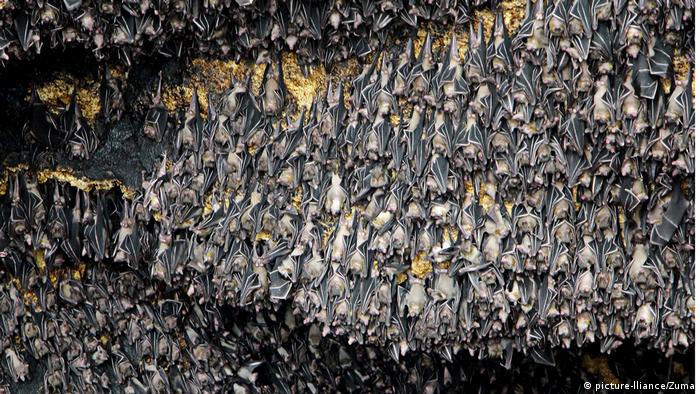
The town of Grafton can host more than 100,000 flying foxes at a time
Travelers in search of wood and water
The Australian mainland has four species of flying fox — also known as fruit bats — two of which are listed as nationally protected species. Some can reach a wingspan of 1.5 meters.
Flying fox camps have been likened to railway stations, where crowds of the animals come and go each day. They may travel up to 50 kilometers (30 miles) in a single night, and 1,000 kilometers (620 miles) seasonally, depending on food availability.
They also need a good source of water, drinking small amounts frequently to stay hydrated without weighing themselves down in flight. Susan Island, located in the middle of the Clarence River that runs through the city of Grafton, has become an ideal congregation spot.
But climate change and deforestation are making their movements less predictable. As their habitat is lost or water sources dry up, they seek refuge in urban or suburban areas. "They're being forced into areas they would not normally be," said Tim Pearson, an ecologist and chair of the NGO Sydney Bats.
And while some Australian towns may be seeing an influx of flying foxes, nationally, their numbers have dropped significantly.
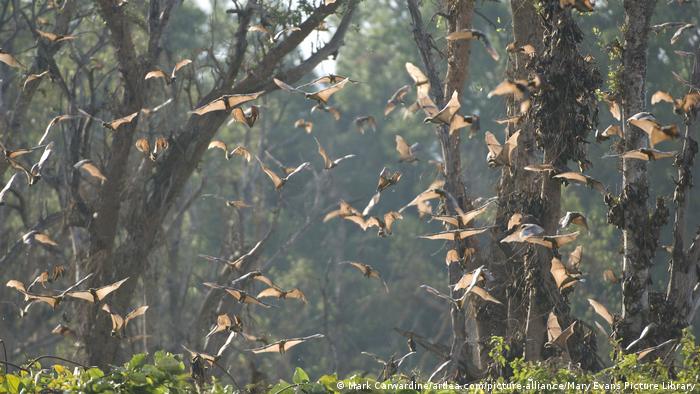
The forest provides a natural shelter from the heat for the animals
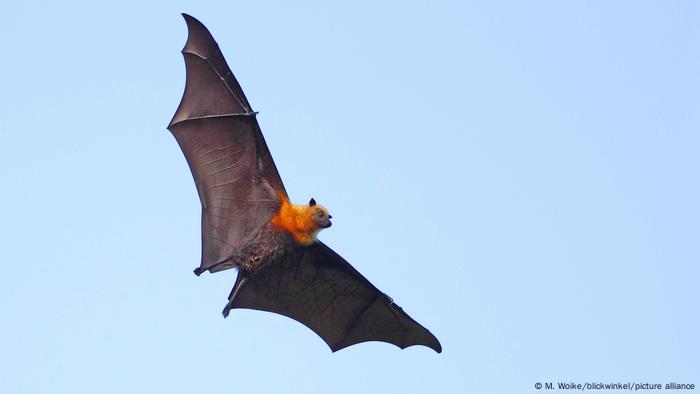
The wingspan for some flying foxes can be as much as 1.5 meters
Perishing in the heat
Extreme temperatures over recent years have wiped out thousands — sometimes even tens of thousands — of animals at a time, with media reports showing heaps of corpses where they have fallen from trees suffering extreme heat stress.
Australia experienced the hottest November on record this year, with temperatures reaching the mid-40 degrees Celsius in some regions.
And bats are more exposed to heat in towns and suburbs where they don't have the protection of thick forest.
"This latest catastrophe to befall some of Australia's largest bat species is a symptom of a much larger problem — Australia's deforestation crisis," said Matt Brennan, head of Tasmania-based Wilderness Society. "Eastern Australia is now a designated global deforestation hotspot, alongside places like the Amazon, the Congo and Borneo."
Extending a helping hand
Some towns are trying to help them. Yarra City council in Melbourne has installed sprinkler systems where flying foxes come to breed in huge colonies on the Yarra River, to try and keep them cool.
And along the Parramatta River in Sydney, the New South Wales state government has helped fund a project to plant trees to provide the bats with more habitat and shade.
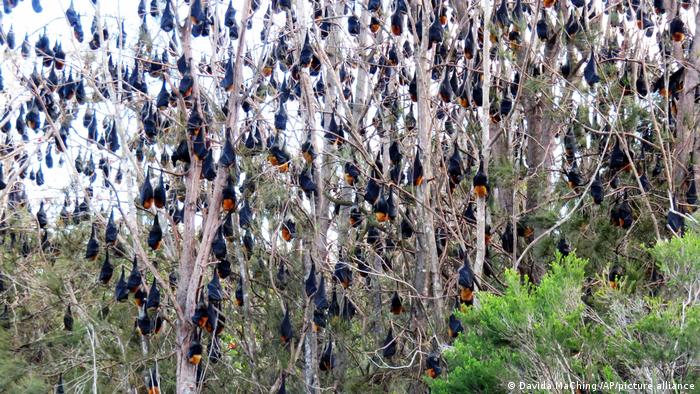
Flying foxes like to stick together
However, these well-intentioned interventions don't always hit the mark. Pearson says sprinklers can startle heat-exhausted animals, increasing their stress levels. And ultimately, making urban environments more hospitable to bats is no substitute for preserving the forests where they are naturally at home.
"You can plant trees to give the flying foxes more habitat, but the real problem is climate change and ongoing deforestation," said Pearson.
Bats need forests, and forests need bats
While flying foxes suffer from loss of trees, loss of fruit bats is, in turn, bad news for trees. As flying foxes pop their heads into flowers to feed on nectar, or consume fruit and excrete the seeds, they help eucalypts, melaleucas, banksias and many species of rainforest trees and vines, to reproduce.
Pearson warns that if we don't address climate change and halt deforestation, Australia's flying fox numbers will fall so low within the next few decades, they will no longer be able perform this vital role.
"I think they will survive in some pockets along the coast where there is food and water," he said, "but they will not be acting as the pollinators and seed dispersers that are so necessary for our forests to survive."
Learning to love our winged neighbors
Pearson is among the flying fox's fiercest defenders. He's studying their vocalisations and says the din their human neighbors complain about is actually the highly developed communication of an intelligent and intensely social species.
He wants the public to stop seeing them as disease-carrying invaders and start appreciating fruit bats for the extraordinary animals they are: "It's through educating people, raising awareness about how important these flying foxes are for ecosystem health that we may be able to save them."
In Grafton, spectators now sometimes gather to watch them on their nightly search for food.
"When I realised people were coming from around Australia just to see the bats here out of curiosity, I started to find out more about them, appreciate them," said Taylor. "People actually row out to the island to see them!"
"I guess the bats are kind of funky," she admits.
/* src.: https://www.dw.com/en/flying-foxes-a...ats/a-55949095

 Puck Futin
Puck Futin
-
01-08-2021, 10:54 PM #5
Hồi đó qua Úc có thấy con này, to cỡ con chó chihuahua trong mấy quảng cáo của Taco Bell, còn bận thêm cái poncho, bay la đà khoảng 3 mét để ăn quả trên cây.
Úc hồi xưa ít có các loại quả ngọt như nhãn, mít, xoài, mãng cầu, chôm chôm. Dân Á châu di cư qua bển ngày càng nhiều rồi bắt đầu trồng mấy cây đó nên dơi tha hồ ăn, còn đem về hang để cúng "cầu nhãn đủ xài" (vì loài dơi hay bị mắt kém).
Don't eat bats.
-
01-08-2021, 11:00 PM #6
-
01-10-2021, 11:09 PM #7
Fishermen kill whale trapped for 19 days
https://news.yahoo.com/fishermen-kil...050748446.html
“There were two ships that worked together to put a rope around the tail fin and force the whale’s head beneath the water”, Mr Yabuki told The Telegraph. “They kept it alongside the boat and it took about 20 minutes for the whale to drown.“That’s a really bad way for an animal to die and I’m shaking with sadness at what I have seen this morning."
-
01-11-2021, 04:18 PM #8
Đắc khỉ ho gà:
Gorillas at San Diego Zoo test positive for Covid in apparent first
https://www.theguardian.com/us-news/...oo-coronavirus
The park’s executive director, Lisa Peterson, told the Associated Press on Monday that eight gorillas who live together at the park are believed to have the virus and several have been coughing. Gavin Newsom, California’s governor, confirmed at his Monday news briefing that at least two gorillas had tested positive while three were symptomatic.
It appears the infection came from a member of the park’s wildlife care team who also tested positive for the virus but has been asymptomatic. The safari park confirmed the presence of Covid-19 through fecal samples from the gorillas, and the test results do not “definitively rule out the presence of the virus in other members of the troop”, the zoo said in a statement.
Veterinarians are closely monitoring the gorillas, who will remain in their habitat at the park, north of San Diego, according to Peterson. “Aside from some congestion and coughing, the gorillas are doing well,” she said. “The troop remains quarantined together and are eating and drinking. We are hopeful for a full recovery.”
In zoos, large cats have been the most common animal to get infected. A four-year-old Malayan tiger named Nadia tested positive at the Bronx zoo in New York in April, and shortly afterward, three other tigers and three lions at the zoo tested positive as well. Bashir, an 11-year-old Malayan tiger at the Knoxville zoo in Tennessee, tested positive for coronavirus in October and went into quarantine with the Malayan tigers Arya, 6, and Tanvir, 11, who were also displaying mild coughing, lethargy and a decrease in appetite. Last month, NeeCee, a five-year-old snow leopard at the Louisville zoo in Kentucky, tested positive.
All have recovered.
The gorilla cases are believed to be the first reported from a zoo in the US and possibly the world. For now, the San Diego park’s wildlife team is closely monitoring their behavior. They are being given vitamins, fluid and food but no specific treatment for the virus.
The zoo officials are working closely with experts who have been treating the coronavirus in humans in case the animals develop more severe symptoms.
Cúm người, cúm ngợm, cúm đười ươi.
-
01-11-2021, 09:26 PM #9
-
01-13-2021, 08:40 PM #10
"Thực trùng"
EU food agency approves mealworms as human food
Mealworms, whole or as powder in pasta, have become the first insect-based food approved by the EU's food safety watchdog. The EU Commission has yet to endorse the decision.
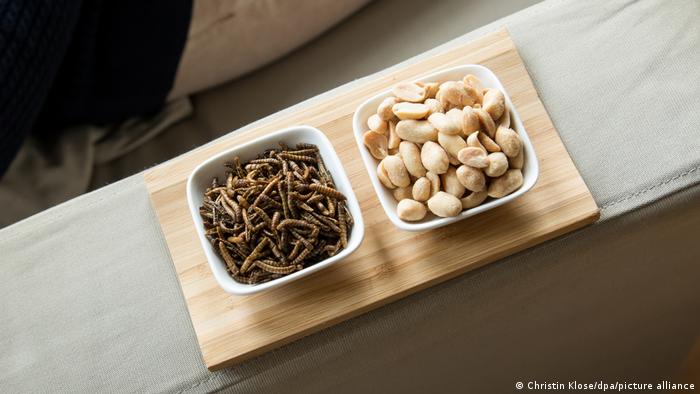
The darkling beetle larvae are already commonly used as food for pet reptiles and fish
Mealworms got approval for EU plates Wednesday from the European Food Safety Agency (EFSA), based in Italy's city of Parma — better known for its tasty pasta, tomatoes, ham and cheese.
Actually larvae of the darkling beetle (Tenebrio molitor) and typically fed to pet reptiles and fish, the yellow grubs could soon be the first "novel food" cleared for sale across the EU, assuming the European Commission adds its endorsement.
Rich in protein, fat and fiber, they could be eaten whole or as a powdered ingredient in snacks and noodles, assuming their original fodder was free of contaminants, concluded the Italy-based EU agency.
Interest 'great' in food sector
EFSA food scientist Ermolaos Ververis said interest was high among the "edible insect sector" of the food industry and the scientific community.
Mealworms are the first species approved among 15 insects subjected to risk assessment procedures delegated to the EFSA in 2018 under a 2015 EU regulation.
The EFSA food agency has 156 applications for "novel food" on its plate. Those also include algae-derived edibles.
'Yuck factor' could dwindle
For many Europeans, eating insects still triggered a "yuck" reaction, said Giovanni Sogari, a consumer researcher at the University of Parma.
"With time and exposure, such attitudes can change," he speculated.
Elsewhere in the world, including Africa and Central America, chewing on insect crisps, cooking with them, even mealworm burgers, have long become norms, so-called entomophagy, alongside massive meat consumption blamed in part for climate change.
Two EU nations, Austria and Germany, already have special dispensations for insect-based snacks.
Answer to food insecurity?
Around the world, thousands of insects are potential candidates —prompting the UN's Food and Agriculture Organization (FAO) in 2013 to speculate that "eating insects can help tackle food insecurity."
Fed even on bio-waste, insects used significantly less water than livestock, and could be farmed more easily, said the FAO.
"For example, pigs produce 10-100 times more greenhouse gases per kilogram (pound) than mealworms," the UN agency said.
Experts warn that some insect species could become extinct globally over the coming decades — largely due to habitat loss as land is converted to intensive agriculture, as well as urbanization and the use of pesticides.
The EU's EFSA cautioned Wednesday that insect proteins were sometimes overestimated and a watch had be kept for potential allergies.
ipj/dj (Reuters, dpa, AFP)
/*src.: https://www.dw.com/en/eu-food-agency...ood/a-56216471

 Puck Futin
Puck Futin








 Reply With Quote
Reply With Quote


